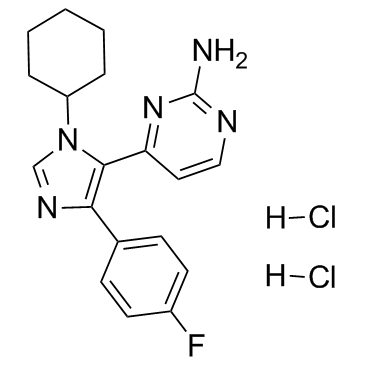950912-80-8
| Name | pf-670462 |
|---|---|
| Synonyms |
CS-1015
QC-8952 4-[1-Cyclohexyl-4-(4-fluorophenyl)-1H-imidazol-5-yl]-2-pyrimidinamine dihydrochloride 4-[1-Cyclohexyl-4-(4-fluorophenyl)-1H-imidazol-5-yl]pyrimidin-2-amine dihydrochloride 4-[3-cyclohexyl-5-(4-fluorophenyl)imidazol-4-yl]pyrimidin-2-amine,dihydrochloride 2-Pyrimidinamine, 4-[1-cyclohexyl-4-(4-fluorophenyl)-1H-imidazol-5-yl]-, hydrochloride (1:2) cc-367 |
| Description | PF-670462 is a potent and selective inhibitor of casein kinase (CK1ε and CK1δ), with IC50s of 7.7 nM and 14 nM, respectively. |
|---|---|
| Related Catalog | |
| Target |
CKIϵ:7.7 nM (IC50) CKIδ:14 nM (IC50) EGFR:150 nM (IC50) SAPK2A/p38:190 nM (IC50) |
| In Vitro | PF-670462 is a potent and selective inhibitor of CKIϵ and CKIδ, with IC50s of 7.7 nM and 14 nM, respectively. PF-670462 shows less than 30-fold selevtivity for EGFR and SAPK2A/p38, with IC50s of 150 nM and 190 nM, respectively. PF-670462 also causes a redistribution of the GFP signal to the cytoplasm in a concentration-dependent manner, with an EC50 of 290 ± 39 nM in CKIϵ-transfected COS7 cells[1]. PF-670462 is a potent inhibitor of Wnt/β-catenin signaling, with an IC50 of ∼17 nM. PF-670462 (1 μM) is a weak inhibitor of proliferation, and only modestly suppresses the growth of HEK293 and HT1080 cells. PF-670462 (100 nM) strongly inhibits CK1ɛ and CK1δ, consistent with its effect on Wnt/β-catenin signaling[2]. |
| In Vivo | PF-670462 (50 mg/kg, s.c.) produces robust phase delays, and the activity remains persistent, with no discernible correction in the absence of exogenous zeitgebers in rats. PF-670462 (25, 50, and 100 mg/kg, s.c.) induces dose-dependent phase shift[1]. PF-670462 (50 mg/kg; s.c.) significantly phase delays the rhythmic transcription of Bmal1, Per1, Per2 and Nr1d1 in both liver and pancreas by 4.5 ± 1.3 h and 4.5 ± 1.2 h, respectively, 1 day after administration. In the suprachiasmatic nucleus (SCN), the rhythm of Nr1d1 and Dbp mRNA expression is also delayed by 4.2 and 4 h, respectively[3]. |
| Kinase Assay | The CKIϵ kinase assay is performed in a 40-μL final volume in buffer containing 50 mM Tris, pH 7.5, 10 mM MgCl2, 5 mM dithiothreitol with 5 μM ATP, 3 nM CKIϵΔ319, and 15 μM peptide substrate PLSRTLpSVASLPGL in the presence of 5 μL of CKIϵ inhibitor (PF-670462) or 5% dimethyl sulfoxide. The reaction is incubated for 3 h at 27°C; detection is carried out as described for the Kinase-Glo Assay. Luminescent output is measured[1]. |
| Animal Admin | Adult male CD rats (initial weight 175-225 g) are released into constant darkness (DD) for 2 weeks, and their individual free-running periods and times of activity onset are determined from the 7 to 10 days at the end of the 2-week period. Dosing of 50 mg/kg PF-670462 or vehicle (40% β-cyclodextrin) takes place at circadian time (CT)9 or 3 h before the predicted onset of activity; night vision goggles facilitated the subcutaneous administration. CT9 is chosen based on preliminary data demonstrating robust responses to CKIϵ inhibition at this circadian time. Animals are maintained under DD for an additional 4 to 5 days postdose, and the data from that time period are used in the estimation of the magnitude and direction of the putative phase shifts[1]. |
| References |
| Molecular Formula | C19H22Cl2FN5 |
|---|---|
| Molecular Weight | 410.316 |
| Exact Mass | 409.123627 |
| PSA | 69.62000 |
| LogP | 6.41880 |
| Storage condition | 2-8°C |
| RIDADR | NONH for all modes of transport |
|---|
